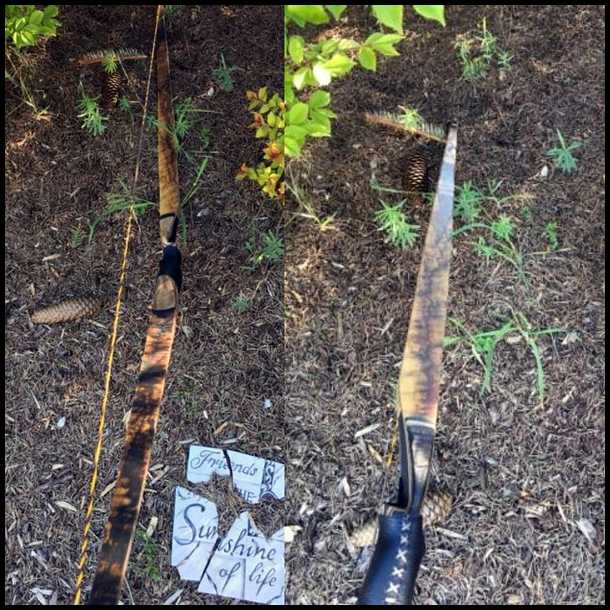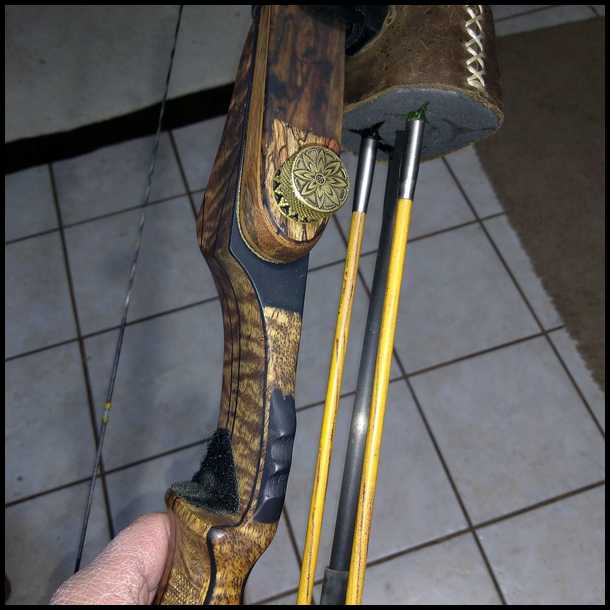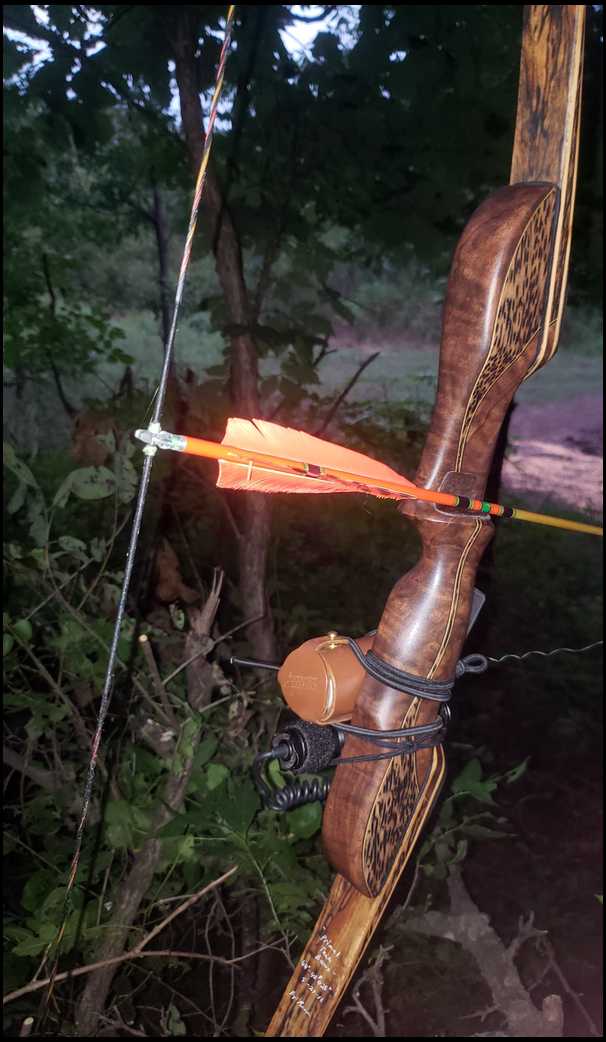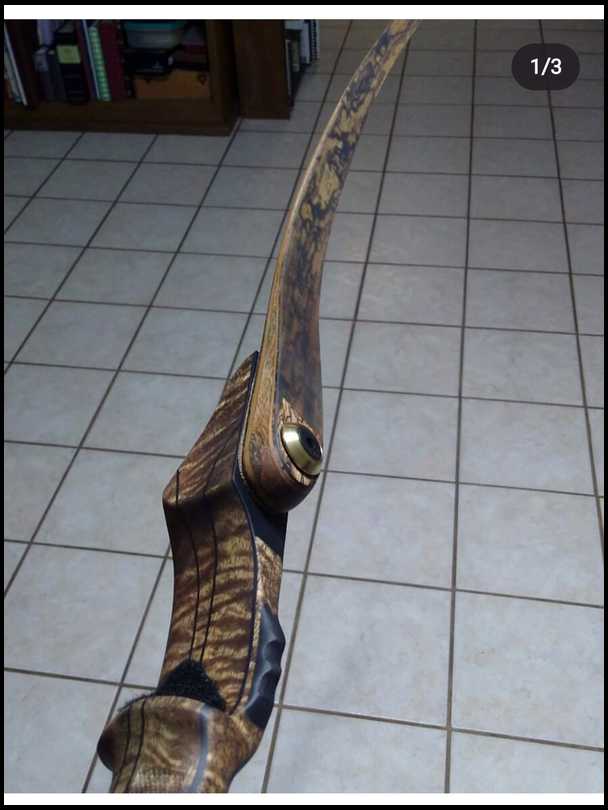| From: Kevin Dill
|
|
|
|
|
|
|
| Date: 01-Dec-19 |
|


No they have not failed. I've had these a few years and would like to use them in a longbow, somewhere around mid 40 pound range. I've had a few discussions with bowyers about the quality and potential failure of heavily spalted veneer laminations. As you can see, these veneers have many small worm holes and defects which transect the thickness completely.
I'm interested to know the opinion of bowyers or those with specific experience in spalted veneer usage. Higher failure rate? Concerns?
|
|
| From: Andy Man
|
|
|
|
|
|
|
| Date: 01-Dec-19 |
|
I have a longbow with lots of pin knots and a longitudinal crack like defect
have shot the bow alot and about 8 years old and no problems
I would think if the wood not pithy and would hold/bond to glue well and glass over should be fine
|
|
| From: George D. Stout
|
|
|
|
|
|
|
| Date: 01-Dec-19 |
|
Not a veneer person here, but those look particularly problematic. The question for me would be why? Usually, if something can go wrong, it will.
|
|
| From: painter
|
|
|
|
|
|
|
| Date: 01-Dec-19 |
|
It would seem to me, and I'm a painter not a bowyer, that the veneer serves absolutely no function other than aesthetics and in fact, may add useless weight and complexity to the limbs, causing a performance loss. Not that beauty isn't a consideration but there is also beauty in simple functional design, polished to performance perfection. I tend to look at my bows as beautiful, functional tools that get carried through the mud and briars on rainy days. I'd rather see the strength of a bamboo grain or even a carbon weave. To each their own.
|
|
| From: Wudstix
|

|
|
|
|
|
|
| Date: 01-Dec-19 |
|
That would add character, as a top layer, but I'm not a bowyer.
|
|
| From: Orion
|

|
|

|
|
|
|
| Date: 01-Dec-19 |
|
If the wood is sound and if used as a veneer, I wouldn't worry about the worm holes. They'll fill with epoxy. May not look so good if they fail to fill completely, and even if they do, but structurally not a problem.
|
|
| From: Bowmania
|

|
|

|
|
|
|
| Date: 01-Dec-19 |
|
Well, I can see WHY you would use them, and I come into the veneer opinion.
They have a core on one side and glass on the other. I wouldn't think they do anything for the structural strength of the limb.
Bowmania
|
|
| From: Kevin Dill
|
|
|
|
|
|
|
| Date: 01-Dec-19 |
|
A bowyer explained to me that epoxy will not saturate and penetrate the full thickness of the veneer. It will of course fill in the worm holes and defects. In the end, the wood in the veneer has to to be strong enough to not fail under stress. The question as I see it, is whether spalted wood has enough integrity to avoid blowing up within the veneer itself.
|
|
| From: trbenoit
|
|
|
|
|
|
|
| Date: 01-Dec-19 |
|
What thickness are they at?
|
|
| From: RC
|
|
|
|
|
|
|
| Date: 01-Dec-19 |
|
Between glass, yes use them...
Heck ya see self bows made with big knot holes in them:)
|
|
| From: grizzley21
|

|
|
|
|
|
|
| Date: 01-Dec-19 |
|
when you glue up the bow,, would the glue fill in all the cracks and worm holes??
|
|
| From: Kevin Dill
|
|
|
|
|
|
|
| Date: 01-Dec-19 |
|
Think of a spalted veneer as a thin piece of wood in the initial stages of decay. It's a glued-in component of the overall limb. It's thin, but it still has to have enough strength to avoid failing between the glue lines.
|
|
| From: 2 bears
|
|
|
|
|
|
|
| Date: 01-Dec-19 |
|
I would probably use them they are so pretty. You might consider using them for overlays on risers, where there would be no flexing. Get some that are solid for limb lamination's. >>>>-----> Ken
|
|
| From: George Vernon
|
|
|

|
|
|
|
| Date: 01-Dec-19 |
|
Kevin, are the veneers 'raw' wood? If so, you might consider getting them resin impregnated. The folks at Blacktail impregnate spalted wood with different colored resins under pressure. My understanding is this gives the veneers some structural strength and makes them easier to grind or otherwise process. Samples I have seen look as strong as phenolic.
|
|
| From: Whitey
|
|
|
|
|
|
|
| Date: 01-Dec-19 |
|
If I tried it I would first impregnate it with phenolic to stabilize it. If it has punky spots it will fail.
|
|
| From: David McLendon
|
|
|
|
|
|
|
| Date: 01-Dec-19 |
|

I have yet to have an issue with spalted veneers and these may go into the making of LB limbs before too long. They have pretty heavy spalting but no worm holes. Patrick Kelly PDK25 has had and has quite a few bows made with spalted veneers as well, I don't recall him ever telling of an issue.
|
|
| From: pdk25
|
|
|
|
|
|
|
| Date: 01-Dec-19 |
|
Well, there has been one issue, out of several bows. This particular one was the Bowyer first attempt with spalted wood. The veneers were left too thick and it basically ripped the veneers apart. The trick is keeping the veneer thin. The same bowyer made another set with thin veneers and there was no problem. If I remember correctly, this entailed gluing the veneer to a thin bamboo lam and sanding it down to reduce the thickness. I could be wrong. If I had any questions, I would ask big Jim. He is an wealth of info. No, he wasn't the Bowyer that I was referring to.
|
|
| From: pdk25
|
|
|
|
|
|
|
| Date: 01-Dec-19 |
|
Small defects like you show shouldn't be a big problem on a thin veneer, as it will fill with glue. Then again, I am not a bowyer.
|
|
| From: Stoner
|
|
|
|
|
|
|
| Date: 01-Dec-19 |
|
My understanding is the fiberglass does the work. Wood will get filled with smooth-on and stabilize. I hope Bodyman Bowyer chimes in. John
|
|
| From: kennym
|
|
|
|
|
|
|
| Date: 01-Dec-19 |
|
I just glued a limb with spalted hackberry veneers at .025" for my next years hunting TD longbow ( if it passes the noise and shootability factor, changed some stuff on the original to see about some free horsepower)
So far I haven't had trouble with spalted veneers but I keep them thin.
|
|
| From: Stoner
|
|
|
|
|
|
|
| Date: 01-Dec-19 |
|
I love character wood. We threw out spalted and very figurative wood in the cabinet shop I worked at. Could never use all I had in a lifetime. When I move from AZ. I gave it all away to a wood worker. Kept some special pieces for future bows that are in my brain still. John
|
|
| From: Babysaph
|
|
|
|
|
|
|
| Date: 01-Dec-19 |
|
I wouldn't shoot a bow with wood that has holes in it with football helmet and catchers mask on.:)
|
|
| From: pdk25
|
|
|
|
|
|
|
| Date: 01-Dec-19 |
|

|
|
| From: pdk25
|
|
|
|
|
|
|
| Date: 01-Dec-19 |
|

|
|
| From: pdk25
|
|
|
|
|
|
|
| Date: 01-Dec-19 |
|

|
|
| From: pdk25
|
|
|
|
|
|
|
| Date: 01-Dec-19 |
|

|
|
| From: pdk25
|
|
|
|
|
|
|
| Date: 01-Dec-19 |
|

|
|
| From: pdk25
|
|
|
|
|
|
|
| Date: 01-Dec-19 |
|
Just some different bows using spalted mango.
|
|
| From: Kevin Dill
|
|
|
|
|
|
|
| Date: 01-Dec-19 |
|
Well, I think it's been well documented that spalted veneers work well enough for many bowyers (who depend on good outcomes) to use them. I'm pretty sure we'd be hearing the stories if failures were happening, aside from the odd one. I still hope some experienced builders show up and weigh in on the subject.
|
|
| From: Dale in Pa.
|
|
|
|
|
|
|
| Date: 01-Dec-19 |
|
I've only ever had one recurve delaminate and that one was built with spalted maple. As I mentioned on another thread the veneer was punky and actually tore apart with most remaining on the core lam next to it but some still attached to the glass on the back.
|
|
| From: pdk25
|
|
|
|
|
|
|
| Date: 01-Dec-19 |
|
The veneers that failed in one of the bows pictured above is from the same batch as the one that failed. The only difference is the thickness. You can't tell the level of decay by looking at the veneer from the outside. All about the thickness and how they are laminated. I an not advocating that anyone use them. but I have had a total of 6 bows using spalted veneers, and they are holding up fine. Making a comparison of seeing whether a spalted or non-spalted wood will break first is really a no-brainer, but not really applicable when deciding if spalted wood can be used relatively safely as a limb veneer. All of the bows above have been hunted with, taken big game, and are doing fine.
|
|
| From: pdk25
|
|
|
|
|
|
|
| Date: 01-Dec-19 |
|
Dale, that is basically what happened with the mine as well. Used the same type of veneer with a different prep and it has worked fine.
|
|
| From: pdk25
|
|
|
|
|
|
|
| Date: 01-Dec-19 |
|

Better look at the veneers of the second bow that I showed a pic of.
|
|
| From: nineworlds9
|
|
|
|
|
|
|
| Date: 01-Dec-19 |
|
Zero issues with spalted veneers in a bow built by a competent bowyer.
This thread has a number of opinions floating around in it that have no real basis in reality or first hand experience, so I advise the casual reader to take some of what they find here with one or two grains of salt.
|
|
| From: Kevin Dill
|
|
|
|
|
|
|
| Date: 01-Dec-19 |
|
I don't have a micrometer to check thickness. I bought these from Curt at The Wood Vault and he lists all his veneers at .030" thick.
|
|
| From: Jeff Durnell
|

|
|
|
|
|
|
| Date: 01-Dec-19 |
|
Spalting is discoloration from fungus that enters when a tree is either dying, standing dead, or allowed to 'control rot' after it's down and rough sawed , and it does cause loss of strength. Often, as it gradually increases in aestetic value, it also loses integrity. The key is to catch it, and stop it/dry it, at the right time. Keeping wood borers out is another issue altogether.
Regardless of what the issue is, I wouldn't use any sort of thin lam, core, backing strip, etc. including a veneer, in a bow if I couldn't bend it, alone, into a substantial arc without failure, damage, or serious concern.
I won't hesitate to use spalted maple if it passes the above test and feels, works, and results like good sound hard maple does. Degradation in regards to usefulness in such 'working wood' is a matter of degree.
Those wood borer holes would be more concerning to me, the way they run across a large portion of the width of the lam in some isolated areas. Even if they filled with epoxy during glue up, I'd be afraid a crack would run from one to another with use.
The veneers also appear to have some alternating or curly grain that, in combination with the spalting and bug holes, further raise my concern just a wee tad. I'm not saying I absolutely wouldn't glue them up, but if I used them at all, I'd reserve them for a bow for myself, and then not fully trust them until they really proved themselves after a few thousand arrows. It woud probably be ok, but... you know.
|
|
| From: pdk25
|
|
|
|
|
|
|
| Date: 01-Dec-19 |
|
Let's not get testy folks. Just share information. What he may have intended to say is that since you have not actually built a bow using spalted veneers, you don't actually know if it would work and really can't quantify the risk. Nothing wrong with you not feeling comfortable, but also no real data, either.
|
|
| From: pdk25
|
|
|
|
|
|
|
| Date: 01-Dec-19 |
|
Kevin, I would talk to Big Jim if you are building the bow yourself, or go with a Bowyer who has done it with spalted veneers enough to be comfortable. I got mine from Curt on all occasions as well.
|
|
| From: nineworlds9
|
|
|
|
|
|
|
| Date: 01-Dec-19 |
|
Pdk answered your question River.
|
|
| From: Jeff Durnell
|

|
|
|
|
|
|
| Date: 01-Dec-19 |
|
Again... spalting isn't the biggest issue... IMO, it's the tunnels from the wood borers traversing a large portion of the width of the lam. Make sure you ask Big Jim and Curt and whoever about whether they've used lams like that too.
|
|
| From: Kevin Dill
|
|
|
|
|
|
|
| Date: 01-Dec-19 |
|
Thanks guys. Appreciate the variety of thoughts on this. I'm a fairly risk-averse guy when it comes to things like this.
|
|
| From: larryhatfield
|
|
|
|
|
|
|
| Date: 01-Dec-19 |
|
We had a bunch of English Yew once froma tree that died from age and disease in a cemetary in England.. We did special limitited edition bows using lams from that century's old tree that was mostly degrade. We applied smooth-on to both sides of the lams when they were .015 or so from finish dimensions, making sure that the epoxy was saturated at any split, open knot, etc.. Then we ran the lams down to specs and again applied a coat of epoxy to all surfaces of the lams and let it air dry for an hour at room temps. Then we applied another coat as we glued the bow up. As far as I know we had zero failures. They were used on recurves and longbows. If you have ever seen that sort of wood you know what we were faced with regarding degrade. For a longbow, I would just follow what we did and try it. Can't be worse than what we worked with.
|
|
| From: 4nolz@work
|
|
|
|
|
|
|
| Date: 01-Dec-19 |
|
My only question would be how the holes full of epoxy would look under clear glass
|
|
| From: pdk25
|
|
|
|
|
|
|
| Date: 01-Dec-19 |
|
Jeff, I agree that the wood borer holes would concern me more than the spalting in this case. Very thin grinding should help, but that is for experts like you, Larry, and Jim to decide.
|
|
| From: bobby bowman
|
|
|
|
|
|
|
| Date: 01-Dec-19 |
|
I have built many bows with spalted limb material, without any problem. Only failure was using some in takedown riser and having limb bolt insert tear out.Small holes and fissues will be filled by the epoxy just fine. this is providing they are kept as a veneer and not thick enough to be a working lam. I know it all is part of "stack' but thinner is better with spalted stuff.
|
|
| From: BigJim
|
|
|

|
|
|
|
| Date: 01-Dec-19 |
|
| BigJim is a Stickbow.com Sponsor - Website |
When handled properly, spalted veneers will not be an issue. I have yet to have an issue with a set of spalted veneers and have at least 200 bows out there with anywhere from light spalt to heavy spalt. Worm holes are not an issue either and I never pre fill them. Sand, glue, and forget!
BigJim
|
|
| From: BigJim
|
|
|

|
|
|
|
| Date: 01-Dec-19 |
|
| BigJim is a Stickbow.com Sponsor - Website |
On ocasion, the look of the worm hole after glue up is less than desireable... probably more to me than anybody. It is very easy to touch these up after glue up. No other worry whatsoever about the tunnels or holes. BigJIm
|
|
| From: Kevin Dill
|
|
|
|
|
|
|
| Date: 02-Dec-19 |
|
Excellent points. I think it makes sense to me that the overall integrity of spalted wood likely isn't as good as 'normal' wood. I understand that veneers have no role in a bow limb except to provide a certain look. It's not a question of a veneer breaking, so much as it is tearing or separating if the actual wood fibers are in poor condition.
While full of pin holes and worm holes, these veneers (mango by the way) seem to be solid. The closeup pictures probably make them look like goners, but to the unaided eye the defects aren't large...just many in number. The look of the holes and other blemishes doesn't bug me....just additional character.
BigJim and anyone else: What preferred final thickness for the veneers?
|
|
| From: pdk25
|
|
|
|
|
|
|
| Date: 02-Dec-19 |
|
I think you would take the comments of anyone who hasn't built bows with, or had bows build with, spalted veneers or similar decay, as being opinion not based on experience, and therefore perhaps to be taken with a grain of salt. Nothing wrong with having a feeling about something either. Perhaps taken with a grain of salt has too much of a negative connotation, but is probably nicer than some of the other ways it could have been phrased as well.
|
|
| From: pdk25
|
|
|
|
|
|
|
| Date: 02-Dec-19 |
|
And just to be clear, I did not tell people to take you opinion with a grain of salt. I think that the people reading this thread are able to decide how much weight to give someone's opinion on the subject.
|
|
| From: pdk25
|
|
|
|
|
|
|
| Date: 02-Dec-19 |
|
I feel that my comments are coming across much differently than intended. I am not bashing you. Actualy doing a poor job of being a referee.
|
|
| From: Nemah
|
|
|
|
|
|
|
| Date: 02-Dec-19 |
|
Use them! RKK
|
|
| From: Kevin Dill
|

|
|
|
|
|
|
| Date: 02-Dec-19 |
|
Take this with the grain of spalt. :D
I'll let you guys know what happens.
|
|
|
|
| From: Tim Finley
|

|
|

|
|
|
|
| Date: 03-Dec-19 |
|
Ive made a lot of bows with spalted veneers and had no problems I try to make the veneers .020 or less so the glue will penetrate all the way through. Worm holes can be mostly covered up and made stronger by sanding a little of the wood and mixing the saw dust with epoxy and filling then take your veneers down. I wouldn't make a bow with .030 veneers they're too thick .
|
|
| From: BigJim
|
|
|

|
|
|
|
| Date: 04-Dec-19 |
|
| BigJim is a Stickbow.com Sponsor - Website |
The best spalted veneers are the most fragile. Fungus continues to break down the fibers and create barriers (black line) and or variant colors until wood drops below 32% MC. After that, the wood can still decay, but the figure accumulation stops.
If caught soon enough, the wood will still have it's full integrity but may lack in figure potential.
If the veneer is solid, I treat it like any other. If not, I go thorugh a series of steps that will allow me to grind it extra thin. The more spalted it is, the more glue it will absorb.
I never fill worm holes before glue up and allow the glue to fill them. I don't try to hide the worm holes as I think it makes a very attractive addition to the wood. BigJim
|
|
| From: aromakr
|

|
|
|
|
|
|
| Date: 04-Dec-19 |
|
What no one seems to relate to is a veneer lays between a lamination and clear glass. Its supported on both sides and saturated with epoxy, plus it only about .010-.015 thick, about the thickness of a piece of copy paper.
Bob
|
|
| From: dabob
|
|
|
|
|
|
|
| Date: 05-Dec-19 |
|
Spalted vine maple is very nice and there is a way it became spalted. The maple I use is from beaver dams sallow ponds that caused water to rise a few inches above the roots and killed the trees, two years after drowning the trees will start spalting. Now this condition will continue for about two years and after that the wood will show signs of dry rot and weakness. I have not had one bow fail because of failure after spalding. I cut spalted lams without a taper, make it up with a yew taper.
|
|
| From: SJR Bows
|

|
|

|
|
|
|
| Date: 05-Dec-19 |
|
Kevin those will work fine and should be no issue. They will make a beautiful and unique bow
|
|
| From: Roger Norris
|

|
|

|
|
|
|
| Date: 05-Dec-19 |
|
I know nothing about bow building....but I am amazed that spalted wood works in that application. Spalted handgun grips are beautiful, especially on a single action revolver....honestly shocked though, that they can withstand the work of a bow limb.
Not doubting anyone.
|
|
| From: Kevin Dill
|
|
|
|
|
|
|
| Date: 06-Dec-19 |
|
Thanks again for the continued insight and experience related here. I was pretty sure the right people would weigh in and help me understand. I'm satisfied my veneers....while full of worm holes and spalted figure...are essentially sound enough to be used. Not that it really matters, but I plan for them to be used in rather low-poundage limbs (40s) which I'll use primarily for off-season shooting.
|
|
| From: Jeff Durnell
|

|
|
|
|
|
|
| Date: 06-Dec-19 |
|
Sounds good, Kevin. If you would, post some pictures when it's done.
|
|
| From: Horsey
|
|
|

|
|
|
|
| Date: 06-Dec-19 |
|
I have used tons of spalted veneers without issue. They are always ground to .025". After slicing the veneers with a bandsaw, but before grinding, if I have a concern about any voids or fissures, I have a method of dealing with them. I cover the back side of the un-ground veneer with clear plastic packing tape and fill the voids with 5-minute epoxy. I hit it with a heat gun to allow the epoxy to become more viscous and flow into the void. Once the glue has set up, I can grind the veneer without fear of it coming apart. The same method is used with some burls with areas that might pop out during grinding.
--Mike Dunnaway
|
|
| From: Crooked Stic
|
|
|
|
|
|
|
| Date: 06-Dec-19 |
|
.030 or less use them. Be sure you get plenty of glue on them. Between glass and a good core good to go.
|
|
If you have already registered, please sign in now
For new registrations Click Here
|
|
|
|



